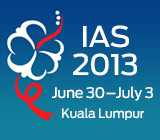 During the history of HIV, clinical trials of antiretrovirals (ARVs) have charted a steady, upward climb in efficacy, according to a large meta-analysis, MedPage Today reports. Researchers culled together findings from all reported prospective trials of ARVs in treatment-naive people with HIV that had at least 48 weeks of follow-up and an intent-to-treat efficacy analysis. This included 144 studies among 216 treatment groups, including 10 trials dating from before the 1996 treatment revolution. The investigators reported their findings at the 7th International AIDS Society Conference on HIV Pathogenesis, Treatment and Prevention (IAS 2013) in Kuala Lumpur.
During the history of HIV, clinical trials of antiretrovirals (ARVs) have charted a steady, upward climb in efficacy, according to a large meta-analysis, MedPage Today reports. Researchers culled together findings from all reported prospective trials of ARVs in treatment-naive people with HIV that had at least 48 weeks of follow-up and an intent-to-treat efficacy analysis. This included 144 studies among 216 treatment groups, including 10 trials dating from before the 1996 treatment revolution. The investigators reported their findings at the 7th International AIDS Society Conference on HIV Pathogenesis, Treatment and Prevention (IAS 2013) in Kuala Lumpur.
The proportion of study participants that reached an undetectable viral load was about 47 percent before 2000, compared with 82 percent of those from after 2008. Those ARV regimens that the U.S. Department of Health and Human Services guidelines panel have designated as “preferred” boasted superior efficacy to the panel’s “alternative” regimens, which themselves outperformed other drug combinations.
To read the conference abstract, click here.
To read the MedPage Today article, click here.
Advertisement
Advertisement
Advertisement






Comments
Comments